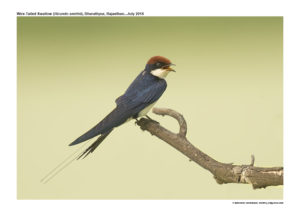Wire-tailed Swallow

Wire-tailed Swallow Hirundo smithii
Etymology:
- Hirundo : Latin word for Swallow
- Smithii : Named after English botanist Sir James Edward Smith (1759–1828)
Vernacular Names: Hindi: Leishra, TardumAbabil, Pun: Tarpunjha, Guj: Lesharaababil, Tharpunchtharodiyu, Mar: Tarwali, Tarshepti/ Tarwalibhingri, Mal: Kambivalankathrikakkili, Kan: Sarigebaladakavalutokae
Distribution in India: Widespread resident except North East, North West and parts of SouthIndia.
Description: Size of 14–21 cm; wt. of 9–17 g. It has rufous-chestnutf orehead and crown, upperparts are glossy blue; wings and tail are black with blue gloss, white patches on inner webs of rectrices, outer tail feathers are elongated to form thin filaments. It is creamy white below, blue patch on each side of breast and on flanks. The female has shorter tail than male. The juvenile is duller, crown is paler, and tailis shorter.
Habitat: It is found in grassland, savanna, open woodland, clearings, cultivation, also human habitations, placesnear water such as lakes, rivers, canals and paddy fields. It is found from middle to low altitudes up to c. 2700 m.
Food habits: It eats flies, beetles, bugs, butterflies and moths, mayflies, Hymenoptera and termites. It forages in pairs or small groups, mixes with other swallows and swifts. It feeds often low down and predominantly over water, and also over open ground and above trees. It occasionally perches on ground to take insects, and follows tractors and large animals.
Breeding habits: They breed in Jan–May and Jul–Dec in Senegal, all year in Gambia, Oct–May in Nigeria, Feb–Apr, Sept and Nov in Sudan, Jan, Mar–May and Aug–Nov in Ethiopia, all year in E Africa, Jun–Jul and Oct in Angola, Jan–Oct in Zambia, all months in Zimbabwe, Mar–Apr and Sept–Oct in E South Africa, Apr–May and Oct–Nov in KwaZulu-Natal; Feb–Sept in Indian Subcontinent, and Jan–Nov in SE Asia. The nest is constructed by both sexes, taking up to 1 week. The nest is an open cup made of mud or of mud mixed with dry grass, lined with grass, rootlets and feathers, sometimes built on old nest of other swallow; above ground, usually affixed on wall, rafter, under overhang or close to a ceiling, in house, verandah, on culvert, bridge, pier, boathouse, boat, water tower, on cliff, in cave, on rock, or on tree overhanging water, and often along or near river, stream, lake, even irrigation channel or rice field.The nests are reused. They lay a clutch of 2–4 eggs. The incubation is done by female. The incubation period is 13–19 days.The chicks are fed by both sexes, older ones more by female than by male. The chicks are given up to 16 feeds per hour. The fledging period is 15–24 days. The young return to nest for several days. The nests are sometimes taken over by White-rumped Swift.